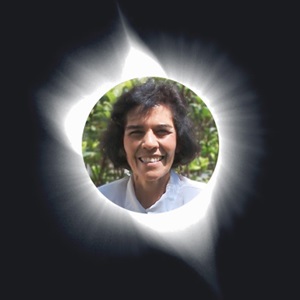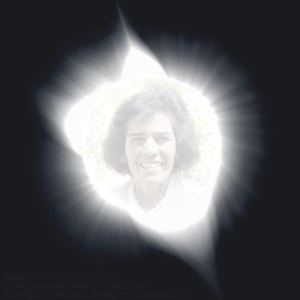Total Solar Eclipse of 3 November, 1994.
|
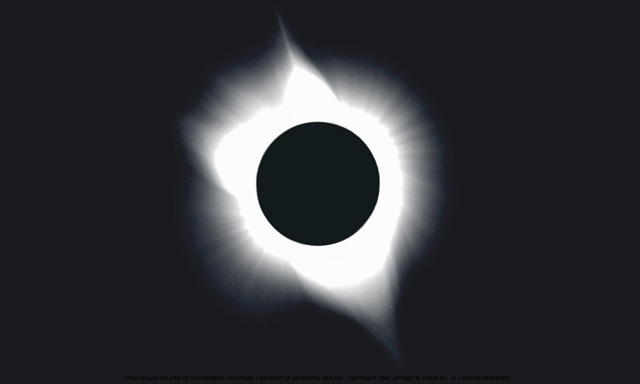
|
| Total Solar Eclipse of 3 Nov. 1994. 94mm f/7 Telescope with Barlow. 1 Sec. at f/10.5, ISO 64 Film Unless noted otherwise, this and all other images are © Copyright 1994 Jeffrey R. Charles, All Rights Reserved. Use of material herein is subject to conditions in the Versacorp Legal Information Page. |
|
Images of the Total Solar Eclipse of 3 November, 1994.
Contents: |
Introduction:
|
The images below are from my 1994 total solar eclipse expedition. I spent over two weeks in Bolivia on this, my only solo eclipse trip to date. The 3 November, 1994 eclipse was my third encounter with the moon's shadow, but the qualities of each eclipse and the circumstances of each expedition make every eclipse unique. This 1994 expedition was very unique!
The 1994 eclipse was the only one I observed and photographed with a "real" telescope; my Vernonscope 94 mm f/7 refractor. In 1979, I used a 300 mm lens and a 2x teleconverter; in 1991, I observed and took pictures of clouds, even though I had a telescope with me; and in 1995, I used a 300 mm ED lens and a Dakin Barlow which was working at about 2.1x. Compared to previous eclipse expeditions, I traveled slightly lighter for the 1994 eclipse, but compared to my later 1995 expedition, I really "porked out" on equipment! To photograph the corona, I brought my Vernonscope 94 mm f/7 apochromatic refractor, an Aus-Jena German equatorial mount, and a 350 mm f/5.6 lens. A SVHS-C camcorder with a home made achromatic 3x converer was used for corona video. To lighten my luggage, I designed and constructed pulsed stepping motor drive for the Aus-Jena equatorial mount. The new drive runs on a 9 volt battery, so I did not have to bring a heavy 12 volt 6AH battery and an inverter. For use with the Vernonscope, I brought along my company's patented flagship astronomy product, the VersAgonal. It allowed me to observe and photograph the eclipse at two focal lengths through the same telescope! I really like the Vernonscope, particularly after I made modifications which included a sliding, self storing dew cap, an iris diaphragm, and shortening the tube to 19". The Vernonscope is compact and has a two inch focuser with a sliding draw tube. The sliding draw tube allowed me to "pre set" the prime focus of the telescope prior to totality. I then used the VersAgonal's built-in Dakin Barlow lens to photograph second contact and the first part totality at a focal length of 1000 mm, then I just turned the VersAgonal's control knob to flip out the built-in lens, after which I simply racked the Vernonscope's focuser all the way in to its stop. This allowed me to photograph the outer corona at the Vernonscope's prime focal length of 640 mm. Then, I used the VersAgonal's built-in flip mirror to observe the eclipse at 20x with my 32 mm wide field eyepiece. After the visual observation, I switched to a different camera body and shot color negative film at prime focus. All of the corona photos (at two focal lengths with one camera and at one focal length with the other) were taken in only about a minute and a half, or less than half of the duration of totality! I also took video of the corona with the above mentioned SVHS-C camcorder and home made 3x converter lens. The converter lens worked pretty well; the first two diamond ring shots below are from the video! In addition to photographing and observing the corona, I took 360 degree panoramic photos of the umbra (each 4 shots with a 16mm fisheye lens) and some shots of the eclipse over the horizon with a 20 mm lens. I also took wide angle video of the umbra with a 0.45x converter lens. Some of the wide angle images were to be used in experiments I was conducting in order to learn more about the visible effects of the lunar umbra and better predict its visible effects at future eclipses, and for more accurate simulations of total solar eclipses in planetariums, etc.
Unfortunately, interference by a few influential locals (political climbers and rich people) in the days shortly before the eclipse, caused me lose so much sleep (and become so ill) that I was like a zombie on eclipse day, which adversely affected my performance. (Details in my 1994 Eclipse Journal.) In spite of this, I was able to obtain many corona photos, including those shown below. (The corona was also photographed in series of different exposures that can be stacked, but it has not been possible to stack these to date.) I was more or less operating on "autopilot" the day of the eclipse, so some of the limited success may be attributable to repeatedly practicing my procedure. Planning and practice for eclipse photo procedures is so important that one paper at my EclipseChaser.com web site is devoted to the subject! The 1994 total solar eclipse images follow. Enjoy!
|
1994 Total Solar Eclipse Images, Corona:
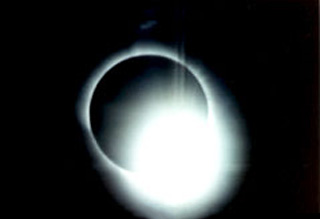 |
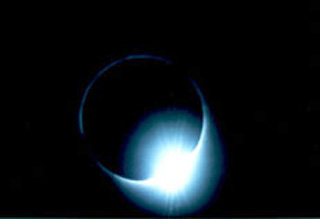 |
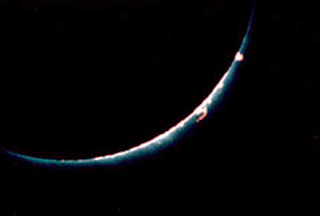 |
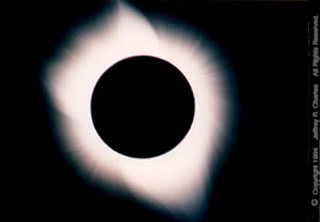 |
| Beginning of Totality from Sevaruyo, Bolivia. (Diamond Ring, Chromosphere, Corona) | |
| The TOP TWO images are from my SVHS-C video camcorder with a home made 3x converter lens. The LOWER LEFT chromosphere shot is cropped from a picture taken with a Nikon N2020 camera on a Vernonscope 94 mm f/7 triplet refractor with a Versacorp VersAgonal multi-function flip mirror attachment. The VersAgonal's built-in 1.5x Dakin Barlow provided a focal length close to 1,000mm. Exposure is 1/500 second at f/10.5 on Kodachrome 64 Professional film. Kodachrome Professional does not have as much artificial greenish tinge on dimmer parts of the corona. LOWER RIGHT: Slightly cropped 1 second exposure shot with the same telescope and film. This is a straight machine print that was made at a conventional photo lab. | |

| |
| Total Solar Eclipse of 3 Nov, 1994. Vernonscope 94mm. 1 Sec. at f/10.5 on ISO 64 Film. | Radially dodged print made from the previous 1 second exposure on Kodachrome 64 Professional film. Note the polar plume detail that is lacking in the smaller "straight" print above. The original slide was printed directly onto black and white paper, so the print was a negative. Digital image processing was used to restore it to a positive. The only other digital processing was to add some dark background beyond the border of the tightly framed original image. I prefer to print the corona in black and white because it eliminates the unrealistic colors that most color films tend to impart to dimmer parts of the corona. If desired, the gray-blue sky color that is present during most eclipses can be digitally restored to the final image. This and all other images © Copyright 1994, 1997, 1998, 2017 Jeffrey R. Charles. All Rights Reserved. |
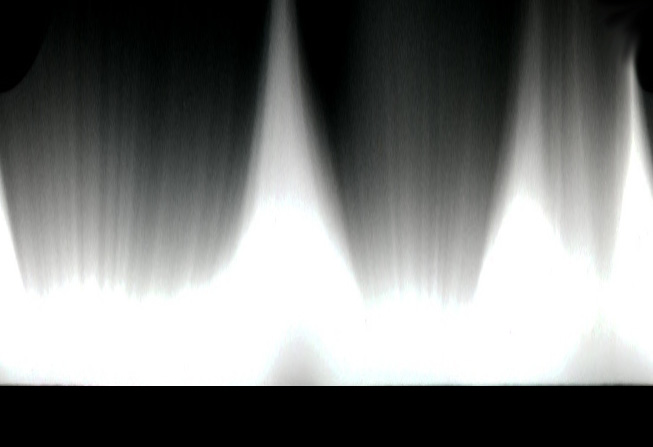
| |
| Polar to Cartesian Conversion of 1994 Corona Image | |
| Another way of looking the corona. Here, the corona has been "unwrapped" into a linear format via digital image processing to convert a "polar" image of the corona into rectangular (Cartesian) coordinates. Radial proportions of the corona are enlarged by a factor of two in order to better show polar plume and equatorial streamer detail. This technique can also be used to enhance digital processing of a corona image, after which the corona image can be converted back into its circular form. A scan of the radially dodged photographic print shown above was used as the original. © Copyright 1994, 1997 Jeffrey R. Charles. All Rights Reserved. | |
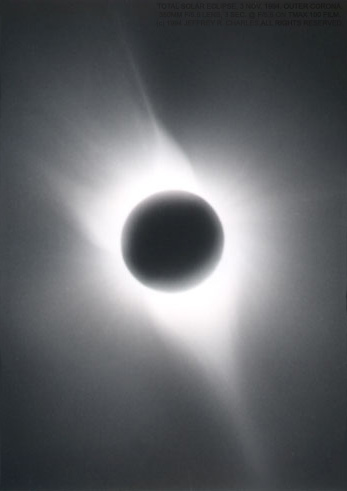 |
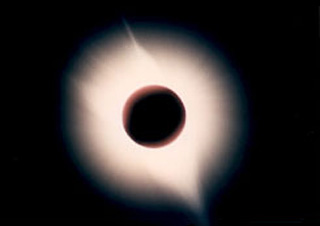 |
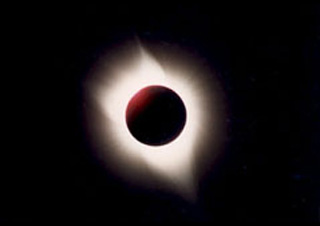 |
|
| Long Exposures of 1994 Corona (1 and 3 Seconds @ f/5.6 and f/7.0) | |
| LEFT: Three second exposure with a 350 mm f/5.6 lens on Tmax 100 film. The lower (eastern) streamer was very long, extending to more than five solar diameters on the original negative - and right out the edge of the picture! This enlargement was radially dodged. UPPER RIGHT: Totality at the 640 mm prime focus of the Vernonscope 94 mm refractor. This is a 3 second exposure at f/7 on Kodachrome 64 Professional film. BOTTOM RIGHT: One second at f/7 on Royal Gold 100 film with same telescope. The red color toward the upper left part of the moon is glare from the emerging solar chromosphere, which is much brighter than the corona. This photo and the one at upper right are straight machine prints. | 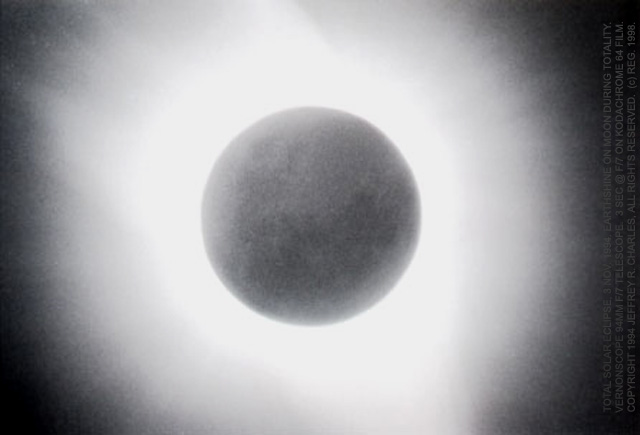 |
| Earthshine on Moon from Above 3 Second @ f/7 Corona Photo | |
| The original film image was printed directly onto black and white paper. Very little dodging was necessary. The only digital processing was to burn in the limb area about 12 percent. | |
Return to Local Table of Contents
1994 Total Solar Eclipse Images, Wide Angle Images of the Lunar Umbra:
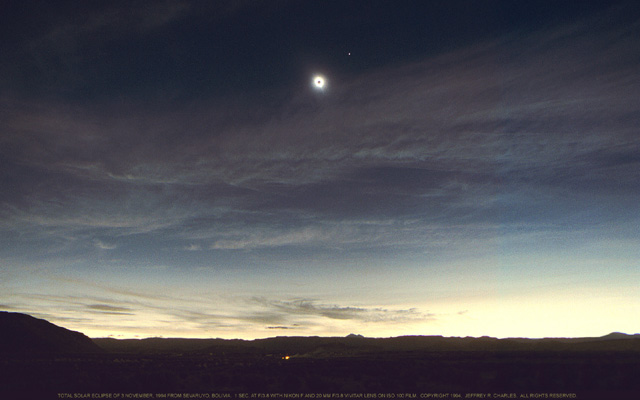 |
|
| Wide Angle View of 3 Nov. 1994 Total Solar Eclipse | Total Solar Eclipse and Venus over Sevaruyo, Bolivia at 8:22:44 local time; 43 seconds after second contact. Exposure was 1 second at f/3.8 with a Nikon F film camera and Vivitar 20 mm wide angle lens on ISO 100 print film. This is a scan of custom print that captured a good amount of dynamic range. |
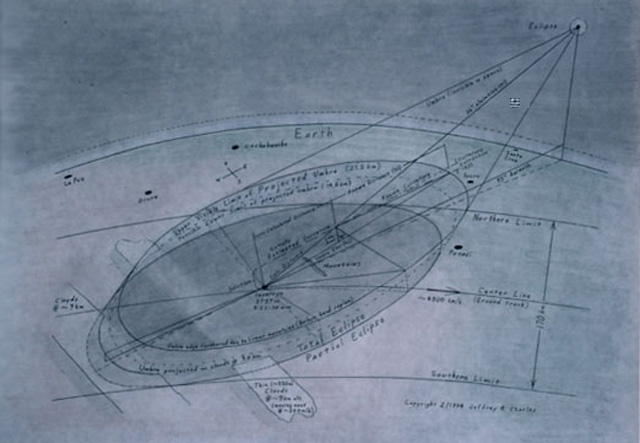 |
|
| Illustration of Lunar Umbra Projected into Atmosphere and onto Earth's Surface | |
| Local circumstances for our encounter with the lunar umbra are shown above. Also shown are geometric representations of equations used in my umbral projection altitude experiment. Projection of the umnbra into the atmosphere is what makes it visible. The umbra cannot be seen in space where there is almost nothing for sunlight to illuminate outside of the umbra. My experiments show that the umbral boundary is typically most visible in a clear sky at an altitude of about 22 kilometers. This is partly due to a relatively high concentration ozone, volcanic material, and other light scattering elements at that altitude in the atmosphere. The most prominent projection altitudes can be somewhat lower at polar latitudes. As I had predicted for this eclipse, yellow color became visible above the northern (and later southern) horizon well before totality began. This is due in part to the relatively low eastern elevation angle of the sun, which causes the leading edge of the approaching umbra to darken the sky ahead of its position on the ground. | |
| The Umbra Approaches: | |
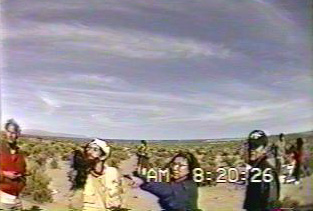 |
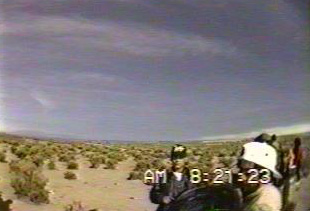 |
| LEFT: Ana Flores (a resident of Cochabamba who kindly offered to interpret and operate one of my cameras after learning I was ill) points out yellow color near the horizon to local observers a full minute and 35 seconds before totality, which began at 8:22:01 local time. RIGHT: Most of the northwestern sky is darkened by the umbra, with 38 seconds to go before totality. By this time, the leading edge of the umbra had darkened the zenith to a deep twilight blue. All images in this series are video frames from a Sony TR-7 Camcorder with a Sigma 0.45x wide angle fisheye attachment that provided a horizontal coverage of about 90 degrees. The video frames were captured with a Snap Magic (TM) video frame grabber. |
|
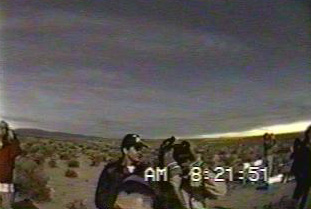 |
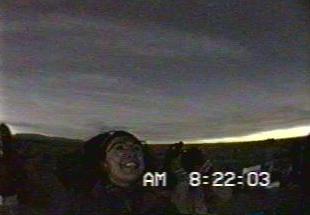 |
|
LEFT: By 10 seconds before totality, the umbra had covered a mountain several kilometers to our west. It is visible as a dark area on the left side of the image. Venus was obvious by this time. RIGHT: Totality! Ana Flores (of Cochabamba) literally jumps up and down with excitement as she sees the corona for the first time. Many observers spontaneously reacted with similar enthusiasm. |
|
| The Umbra Departs: | |
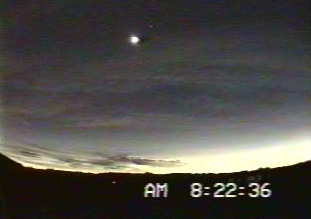 |
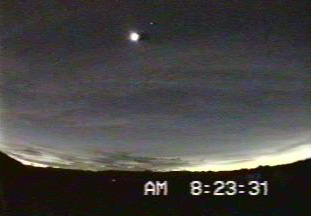 |
| LEFT: By 35 seconds into totality, the leading edge of the umbra continues toward the eastern horizon. Even where there are no clouds, the boundary of the moon's shadow (umbra) is visible in the sky. This is because there is no direct sunlight inside the umbra, and significant sunlight is only scattered by the atmosphere up to an altitude of 22 km or so. The maximum altitude of significant scattering can be lower in polar latitudes. RIGHT: One minute, 30 seconds after the beginning of totality (and one minute, 37 seconds before the end of totality) the leading edge of the umbra is much closer to the horizon. Differing angles of the leading edge are caused by the umbral direction of travel being partly toward the right of the solar azimuth. |
|
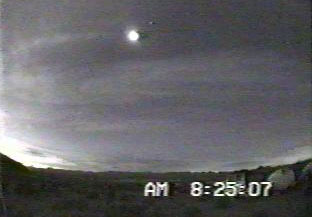 |
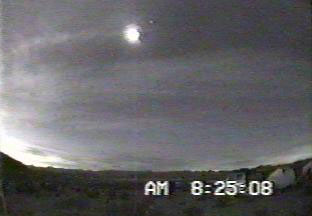 |
| As the umbral boundary moves across the solar position at third contact (the end of totality), its rapid motion is detectable in images taken only one second apart. The ground speed of the umbra was over 0.7 km per second. The LEFT image is one second before third contact. The RIGHT one is at third contact. |
|
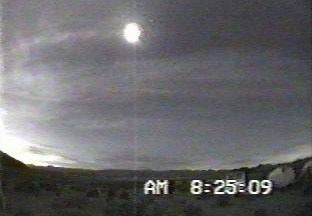 |
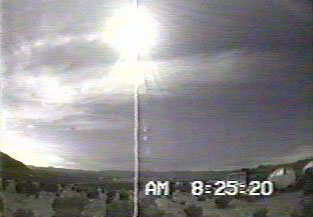 |
| LEFT: Only one second after third contact, further umbral motion is detectable. RIGHT: By 12 seconds after third contact, more of the oval shape of the umbra is within the field of view. |
|
Return to Local Table of Contents
360 Degree Panoramic Images of the 1994 Lunar Umbra.
|
The 360 degree panoramas and other wide angle images were used in experiments I conducted in order to learn more about the visible effects of the lunar umbra. In particular, I was anticipating that observations from the high altitude site would allow me to better determine the altitude, or altitudes, at which the boundary of the lunar umbra is the most visibly projected on the earth's atmosphere. Hopefully, this would provide the means to predict the appearance of the umbra at future eclipses, and to more accurately simulate total solar eclipses in planetariums, etc. While corona photos can be taken at any time during totality, timing and exposure settings are crucial for umbral photos if one is to take advantage of optimum conditions.
Unfortunately, interference (major impositions) by several influential locals (politicians, wannabe politicians, and rich people) in the days prior to the eclipse caused me lose more sleep than I had in many years, and to become ill, so I was like a "zombie" on eclipse day. This interfered the proper execution of my procedures (particularly changing the shutter speed at the right time) for taking the crucial panoramic photos. The biggest problem was being too spaced out (from exhaustion) to remember to change shutter speeds on the camera taking panoramas after a few rich locals had occasionally, though perhaps unintentionally, blocked my access to it, interfering with the flow of my procedures. Auto exposure could not be used for these panoramas because each picture in a given panorama must have the same exposure if it is to be of value for the experiment. Because of this, it was necessary to conduct the experiment all over again at another eclipse (24 Oct. 1995, in Thailand) to even partially recover the work. Haze in Thailand influenced data that could be acquired, but the 1995 data at least made it possible to publish preliminary results. The results to date are here: Predicting the Appearance of the Lunar Umbra at Future Total Solar Eclipses. (Oddly, it then cost less to go to Thailand than to Bolivia. This is one reason I could barely afford to go to Thailand, but not back to Bolivia, after I was laid off in 1995. I had wanted to return to Bolivia to see southern sky objects and visit people I did not get to spend much time with in 1994. The political wannabes, etc., mentioned above interfered with everything.) Raw images for the 360 degree panoramas of the 1994 eclipse are shown below. The panoramas taken during totality and at third contact are too underexposed to show much detail, but image processing may bring out some detail. Fortunately, I took a wide angle video panorama during totality, so it is hoped that I can eventually register and combine the images from both sources. This will take some time, so better panoramas may not be uploaded very soon, if ever. |
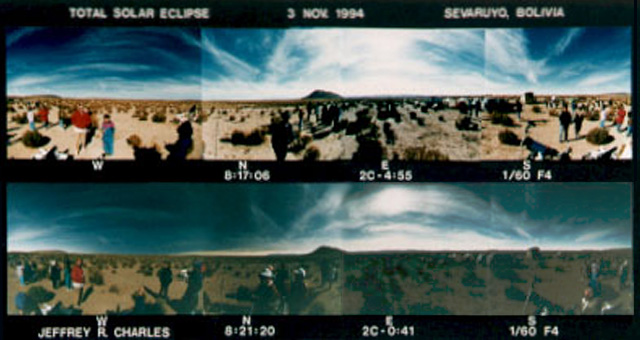 |
|
| 360 Degree Panoramas of Lunar Umbra Approaching Sevaruyo, Bolivia Eclipse Site | These 360 degree panoramas were taken just before totality at the 3 Nov. 1994 total solar eclipse. The TOP panorama was taken 4 minutes, 55 seconds before totality, when the umbra only appeared to be a subtle darkening low in the northwestern sky. The BOTTOM one was taken only 41 seconds before totality, when the umbra covered most of the sky toward the north and west. At this time, the sky near the zenith was deep blue and Venus had become visible near the sun's position. The cirrus cloud band cleared the sun in time for totality. In spite of the cloud, it was possible to incidentally glimpse the entire silhouette of the moon against the inner corona at least 25 seconds before totality began. (It is not safe to look at the sun before totality, and especially that long before totality, but I was so zoned out that I forgot.) |
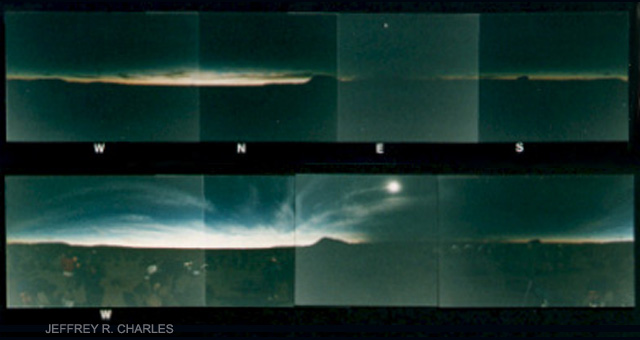 |
|
| 360 Degree Panoramas of Lunar Umbra Engulfing Sevaruyo, Bolivia Eclipse Site | The TOP (underexposed) 360 panorama was taken 30 seconds before the end of totality. The umbra occupies the entire sky except for areas relatively near the horizon. If this, and a panorama planned for 1.5 minutes earlier (that was never taken), had been properly exposed, the shape of the umbra, combined with the cirrus cloud bands and the high site elevation, would have made these by far the most dramatic pictures I ever took at a total solar eclipse, or that would even be possible at any other eclipse for decades. (I was like a zombie at the eclipse, after recent impositions by politicians, wannabe politicians, and their cronies, to the tune of up to 10 hours a day, resulted in exhaustion.) The BOTTOM panorama (also underexposed) was taken 15 seconds after third contact. On the right side of the panorama, the umbra occupies a large oval area that extends all the way from the east-northeast to the southwest. |
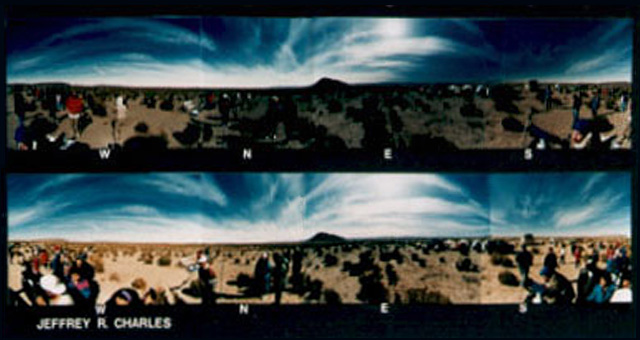 |
|
| 360 Degree Panoramas of Lunar Umbra Departing Sevaruyo, Bolivia Eclipse Site | These 360 degree panoramas were taken after totality. The TOP one was taken 44 seconds after the end of totality, while the umbra still covered most of the southeastern sky. The exposure was 1/4 second at f/4 on ISO 100 print film. The BOTTOM one was taken one minute and 38 seconds after totality. The umbra appears to be just a subtle darkening in the southeast as it races toward other lucky eclipse chasers. The umbra disappeared from view in a relatively short time after totality, compared to the longer time it was visible before totality. This is mostly because the footprint of the umbra at its prominent projection altitude in the sky was east of its position on the ground. This caused the east end of the visible part of the umbra to overhang the ground footprint before totality, while the opposite was true after totality. Atmospheric scattering can also partially obscure the umbra when it is near the solar azimuth at times other than totality, but scattering at this eclipse was remarkably low. |
Return to Local Table of Contents
Instrumentation for the 3 Nov. 1994 Total Solar Eclipse
|
As with previous total solar eclipses, the equipment used for the 3 Nov. 1994 eclipse was mostly limited to the cameras, lenses, and telescopes I already had. This time, the reason was more about lack of time rather than finances. Planning and developing a procedure required a considerable time by itself. Most of the 1994 setup used the same equipment as the 1991 eclipse.
However, I did acquire a compact JVC GR-SZ7 S-VHSc camcorder shortly before the 1994 eclipse trip. It was acquired because a second camcorder would be needed to simultaneously obtain umbra and corona video. Also, due to their higher tape transport speed, S-VHS camcorders tend to have fewer recording artifacts than Video8 or Hi8 camcorders. This particular camcorder also has a "slow shutter" feature that accommodates exposure times of up to one second. Combined with the camcorder's f/1.2 lens, this proved to be handy for taking video at night, including of the night sky. A few months before the eclipse, I had also bought two Fisher Video 8 camcorders that were on sale for less than $400 each at the local Sears store. This increased the total number of camcorders to four. One of these new camcorders was intended for wide field corona imaging (since the camcorder with the 3x converter could not be zoomed out very far), and the other was for "walk around" video at the eclipse site. However, a local person ended up using the second Fisher camcorder after I fell ill, because it was then apparent that I would not be up to using it. I was one camera short for the photography and data collection program I had in mind, and was going to share one camera body with a lens on the main tripod by removing the lens during totality, then using the same camera body on my Vernonscope 94mm refractor toward the end of totality, in order to shoot both color negative film and color slides. Removing a lens to swap the camera was a time consuming process for during totality. Fortunately, my brother loaned me his Nikon F body, to use along with a loaned 350mm lens that was already in the eclipse setup. This provided enough cameras that one could be dedicated for use on the refractor toward the end of totality. In 1994, I still did not have custom brackets to facilitate using multiple cameras on a single tripod, but had acquired something that was similar in concept. Bogen made a cross bar that could support four cameras. (The 2024 equivalent is the "Manfrotto 131DDB Accessory Arm for Four Heads.") The cross bar is about 23 inches long, and has three sliding cast aluminum assemblies. The center casting attaches to a tripod, and those on each side accept 3/8-16 threaded tripod heads. The bar also has 3/8 threaded studs at each end, so it can accommodate four tripod heads in total. Draft on the castings did not provide a flat mounting surface, but it worked fine after the surface was milled flat in the machine shop. (Filing can accomplish the same thing, but takes more time.) By using the cross bar, the 1994 equipment weighed less, required less space, and had a shorter setup time. However, some of aspects of the equipment had to be disassembled down to almost component level in order to fit in the luggage I could handle at an airport and transport on a flight. Even after this disassembly, the equipment (plus my clothes) still required two checked bags and two carry on bags. The disassembly that was necessary for transport by air required that I have at least a full day of time to reassemble and test the equipment after arriving in the host country (Bolivia). Unfortunately, less than two hours after I arrived in Cochabamba, Bolivia (which is where I was going to spend most of the trip) I was blindsided by an aspiring (but failed) local politician and his rich cronies, who imposed themselves on me, sometimes in an intimidating way, especially given that I was less assertive than usual while sleep deprived. Their demands prevented having enough time to either get enough rest or fully prepare the equipment, and my lackluster 1994 eclipse results show it. (These men also interfered with every other aspect of the trip.) Equipment used for the 1994 eclipse included the following cameras. Nine cameras were used, with one of them being borrowed. The cameras are listed with the widest angle first, then ordered according to decreasing field of view:
| |
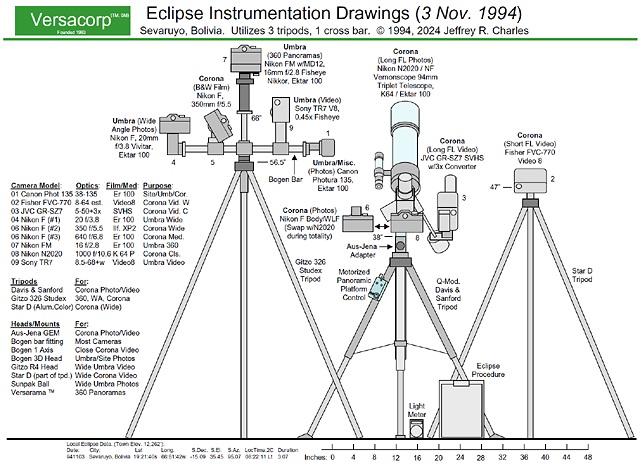 |
|
| Drawing of Cameras, Instruments, and Tripods used at the 3 Nov. 1994 Total Solar Eclipse. | |
| Drawing of equipment used at the Total Solar Eclipse of 3 November, 1994, which was observed from Sevaruyo, Bolivia. The Bogen cross bar on the left tripod made it possible to mount 5 cameras on that one tripod, which reduced setup time. Objectives included capturing 360 degree panoramas before, during, and after totality (as I did in 1991, but it was cloudy then) for use in my experiment to determine the most obvious projection altitudes for the lunar umbra in a clear sky. Unfortunately, a failed politician in Cochabamba and his rich friends interfered with almost every aspect of the trip to Bolivia, including rest and in-country eclipse preparations, and the experiment largely failed. This is a low resolution 640 pixel wide image. Click HERE for a larger image (1650 x 1200, 496 KB) Copyright 1994, 2024 Jeffrey R. Charles, All Rights Reserved. | |
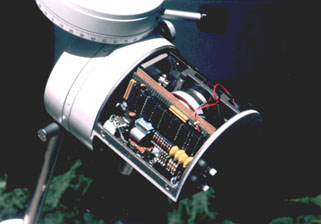 |
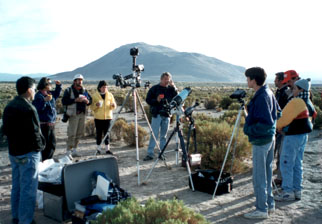 |
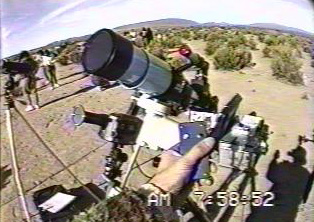 |
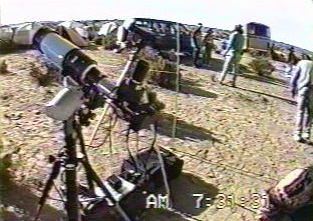 |
| Telescope and 360 Degree Panoramic Imaging Instrumentation at 1994 Eclipse Site | |
| UPPER LEFT: Home made pulsed stepping motor drive circuit for Aus-Jena German equatorial mount runs on internal batteries. The motor itself is from a Super Polaris motor drive assembly. UPPER RIGHT: Equipment set up at a site near Sevaruyo well before first contact. My 1991 prototype motorized indexing panoramic camera platform is on top of the tallest tripod. It was used for the 360 degree panoramas. LOWER LEFT: Vernonscope 94 mm f/7 telescope, seen from the east. The dew cap was moved back in order to accommodate my solar filter, which was made for a different telescope. My video camera and home made 3x converter lens are on the Aus-Jena equatorial mount's counterweight shaft. The small control box in my hand is a remote control for my motorized indexing rotary panoramic camera platform. LOWER RIGHT: Vernonscope 94mm telescope, seen from the northwest (mount is aligned for S. hemisphere). Under the tripod is a VCR claimed to be from PAT, a local TV station which I allowed to take a feed from my video camera. |
|
Our Group's Journey from Cochabamba to the Moon's Shadow
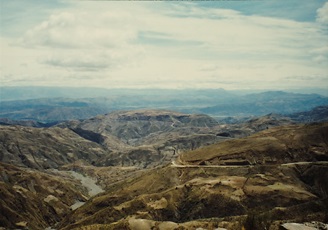 |
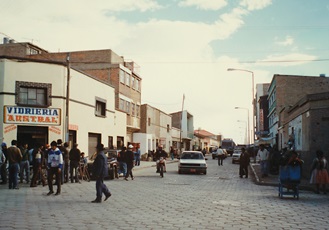 |
| Our group convoyed from Cochabamba to the 1994 total solar eclipse site on the Altiplano (1 km west of Sevaruyo) in one bus and one van. About 70 percent of the route was paved. Most unpaved road was between Huari and Sevaruyo. The trip takes about 10 to 11 hours if there are no vehicle problems. The bus blew a tire, so the trip up took 15 hours. LEFT: The road from Cochabamba to Oruru (4) negotiates rugged terrain as it winds its way up to a maximum altitude of 4800 meters. Cochabamba is in a wide flat-bottomed valley in the distance, with the visible part being just outside the left border of this picture. (A close up of the northwestern part of greater Cochabamba from this location is below.) This photo was taken with a Canon Photura 135 film camera (at 38mm), from near a high bridge (Viaducto Alfonso Subieta) that is pictured below, at the end of the "Images of Bolivia" section of this web page. RIGHT: Busy street in Oruro. This photo captures a rare moment when pedestrians could be on the street. Most traffic was very fast, and some people had to wait up to 10 minutes to cross the street. |
|
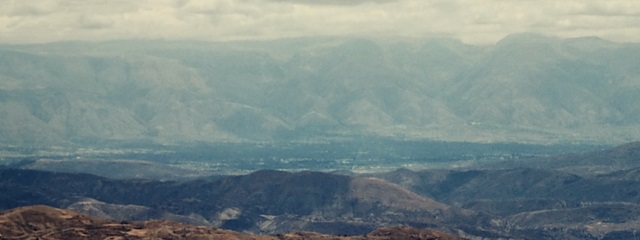 |
|
|
Close up of Cochabamba (taken with a 135mm lens) from the same location on the road to Oruru as the photo above. This view is toward the north-northeast. Trees and other vegetation in the city make it look darker than the surroundng ground. The main part of Cochabamba is farther toward the right than what can be seen from here. That area (including the large Cristo statue) is obscured by foreground mountains. The area shown here is west and northwest of Cochabamba proper, and includes El Paso on the extreme left, Tiquipaya near the middle, and Colcapirhua and beyond toward the right. The faint ligher colored diagonal line just right of center (which points toward the one o'clock direction in the photo) is Ave. Reducto. The lights of the Cochabamba area are visible from this location at night. |
|
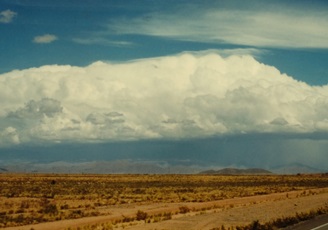 |
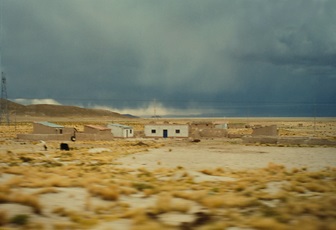 |
| LEFT: Storm over the Altiplano, at 2:17 pm on the afternoon before the eclipse. The shadow under the storm has some similarity to the appearance of the lunar umbra 3 to 6 minutes before or after totality at some total solar eclipses. This photo was taken from the bus, probably while on the paved road well outside of Oruro. RIGHT: Deluxe accommodations on many rural parts of the Altiplano. The weather deteriorated as we got closer to the eclipse site, but it was mostly clear for the eclipse the next morning. |
|
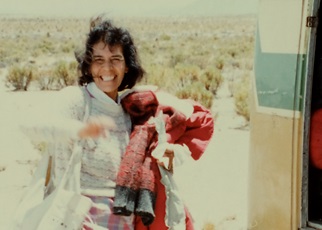 |
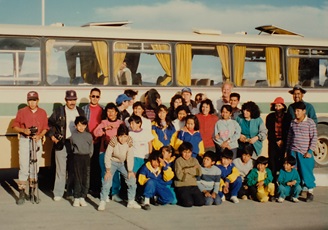 |
| Photos of Our Group's Expedition to the 1994 Total Solar Eclipse Site | LEFT: In a light-hearted moment after the eclipse, a radiantly smiling Wilma Alcocer (of Colegio Buenas Nuevas) prepares to load some cold weather clothing back onto the bus. RIGHT: The part of our group that traveled by bus poses for a picture on the way back to Cochabamba. I am not in this picture since I was behind the camera. The bus blew two tires on some of the rough roads we encountered. Our group included members of my host family, some of their friends, Wilma Alcocer and a few students from Buenas Nuevas; and a few students from other schools. A local missionary with some of his friends and associates traveled in a van. |
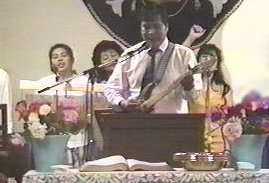 |
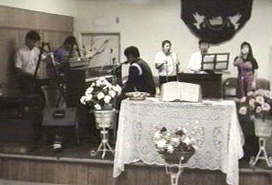 |
| Church I Attended in Pasadena, CA, Circa 1992. Pastor is from Cochabamba, Bolivia. | |
| LEFT: This set of images begins with the Latino church I attended in Pasadena, California. At the time, I was the only Anglo person in the congregation. The person leading music is the pastor, who is from Cochabamba, Bolivia. He and some other members are accomplished musicians. RIGHT: A few people get together for choir practice. This church was once associated with the Guatemala-founded denomination "Elim", but became affiliated with Ministerios Llamada Final in the summer of 1992. |
|
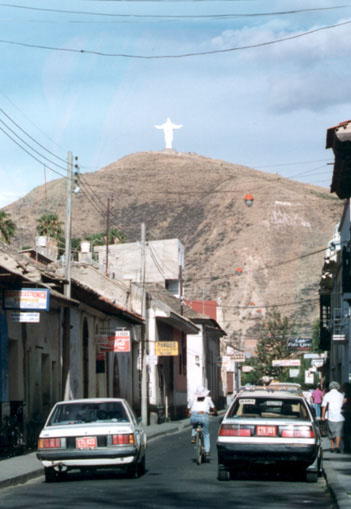 |
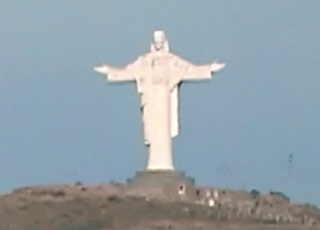 |
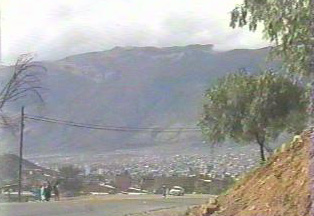 |
|
| Cochabamba, Bolivia (1994) | |
| LEFT: This large Cristo statue overlooks Cochabamba from a mountain east of town. Some local people say it is two meters taller than the famous statue in Rio. UPPER RIGHT: Close up of the Cristo statue. (Frame grab from analog video.) LOWER RIGHT: Picturesque setting of Cochabamba, Bolivia, as seen from the south part of town. |
|
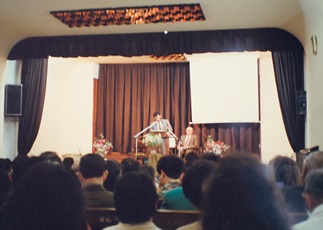 |
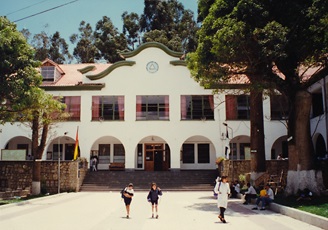 |
| Left: Church in Cochabamba, Bolivia. Right: School in Cochabamba (1994) | LEFT: Iglesia Cristiana Evangelica in Cochabamba, Bolivia. This is the same church that the Pasadena pastor and his wife has attended before (legally) coming to the USA. This church had some simiarities to the one in Pasadena, except that the service was more formal and programmed, similar to that of some conservative churches in the U.S. RIGHT: Colegio Instituto Americano, one of the fancier schools I visited in Cochabamba. I was informed that it accommodated about 900 students. This school appeared to have about twice the assets per student than many schools for less privileged children. But the other schools partially made up for this by having two shifts per day instead of one, to accommodate twice as many students. What matters most is what is taught in the classroom, not the physical campus. |
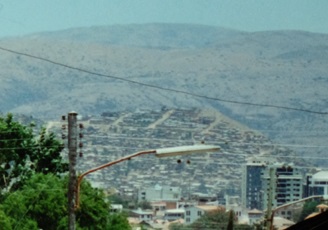 |
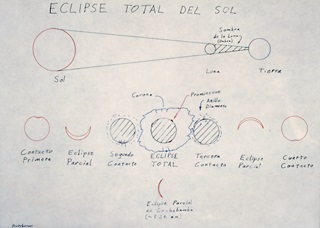 |
| L: View Across Cochabamba. R: View graph made before late arrival of luggage (1994) | LEFT: Two extremes from one location. Distant hills on which many economically disadvantaged people live can be seen from the well-to-do Instituto Americano campus. The differences in opportunity are significant, but some of the staff at schools in less well off parts of town are so dedicated to their students that they can make a difference. RIGHT: One of the primitive eclipse presentation view graphs I had to make by hand on the spur of the moment, before the luggage with my 80-slide presentation arrived two days late. The thin crescent drawn at the bottom represents what the eclipse was to look like from Cochabamba, where it was only a deep partial eclipse. Spelling in the Spanish text I wrote on the view graph while more sleep deprived than I had ever been in over a decade (see my 1994 eclipse journal for why I was sleep deprived) probably made for a good laugh among some of the local students. |
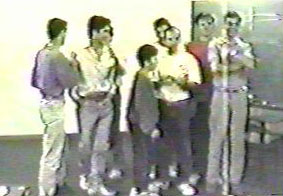 |
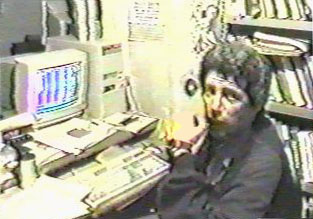 |
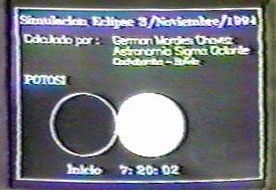 |
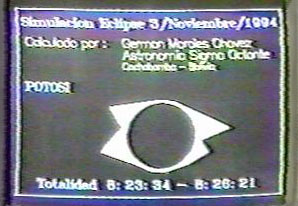 |
| Astronomia Sigma Octante in Cochabamba, Bolivia (1994) | |
| Astronomy in Cochabamba. TOP LEFT: A few members of Astronomia Sigma Octante, a center for astronomical research in Cochabamba, Bolivia. ASO members conduct regular observations of sunspots, variable stars, and other astronomical objects. They are much more than armchair astronomers. (This and some other images are noisy because they are from analog video.) TOP RIGHT: German Morales, the director of ASO. (Sadly, German Morales passed away circa 9 Sept. 2021.) BOTTOM: Computer simulation of 3 November, 1994 total solar eclipse, written by German Morales. The left image shows first contact. The right image shows a simulated image of totality from Potosi, along with the predicted time. |
|
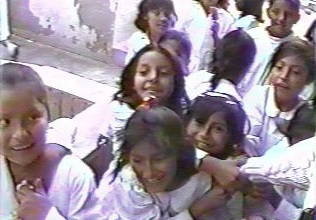 |
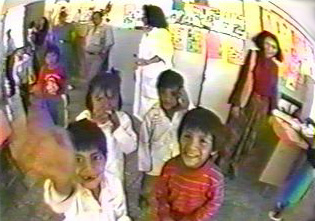 |
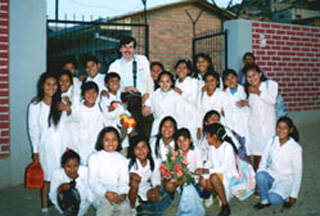 |
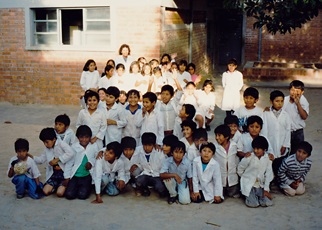 |
| Colegio Buenas Nuevas in Cochabamba, Bolivia (1994) | UPPER LEFT: When I arrived for a goodbye luncheon at the school (colegio) Buenas Nuevas on 10 November, I was unexpectedly "swarmed" by appreciative students. Here, children hang on to me as I make my way through the school. My arm is in the lower right corner of the image, where a different child was holding each finger. Never had anything like this happen before or since. It was a joyful experience that touched my heart. The children are dressed in white, but the second generation copy of my video (from which I grabbed some frames for this web page) had a magenta cast. UPPER RIGHT: Some of the younger children in the crafts room at the school. Students and staff presented me with a nice wood picture frame and other items that they had made. I later used the frame with a picture of the 1994 eclipse. LOWER LEFT: Group of students, with me in the back row. (I heard from a few on rare occasions decades later.) LOWER RIGHT: Wilma Alcocer (a PM Director at Colegio Buenas Nuevas, in back row) with some of the students. |
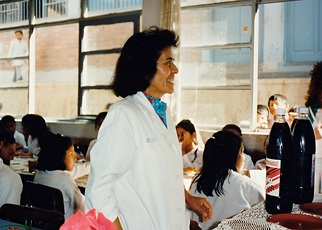 |
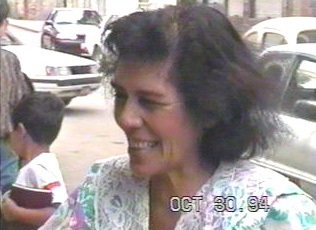 |
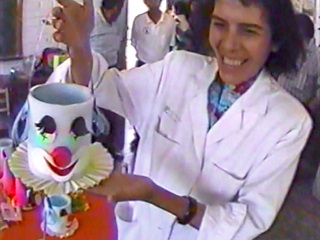 |
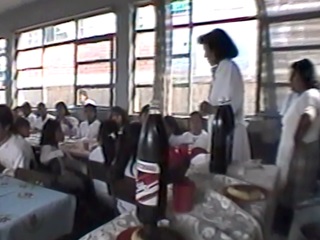 |
| Colegio Buenas Nuevas in Cochabamba, Bolivia: Wilma Alcocer (1994) | |
| UPPER LEFT: Wilma Alcocer (PM shift Primary Director) in a classroom at Buenas Nuevas that was temporarily arranged to host a gracious goodbye lunch they had for me. It was a wonderful time that I appreciate to this day. UPPER RIGHT: Wilma Alcocer, then the Director (i.e. Principal) of the PM shift at Colegio (school) Buenas Nuevas in Cochabamba. Seeing to the welfare of children there was more than just a job to her. Buenas Nuevas is the school at which some influential locals did not want me to appear for eclipse presentations, even though that was prearranged. It is also the school I most enjoyed visiting. (Fortunately, political wannabe types made fewer demands and impositions after the eclipse, so I was free to accept a kind invitation to visit Buenas Nuevas again on 10 Nov.) Many of the children are from relatively poor families. Some buses are run, but many students typically have to walk to school. Sadly, Wilma Alcocer passed away on 22 August, 2023. She will be missed by many. (More about her is in my 1994 eclipse journal.) LOWER LEFT: Wilma Alcocer shows the crafts that some of the younger students made. She cared for the students there. You can see it in her face as she as she shows their crafts. She made a difference every single day. LOWER RIGHT: Wilma Alcocer prepares to pray before lunch in a Buenas Nuevas classroom. Like some other images on this web page, this photo is not very sharp because the original is a video frame. (This pair of photos added 2023.) |
|
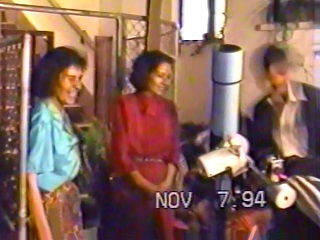 |
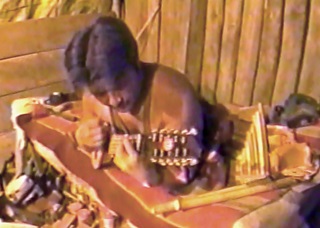 |
| L: Looking at Saturn Through Telescope. R: Musical Instrument Manufacturer (1994) | LEFT: Wilma Alcocer (of Buenas Nuevas) and a person she knows look at my telescope, while someone else looks at Saturn through it. This was at a party for Wilma's 51st birthday. Given local interest in looking through the telescope, I wished I could have also set up my telescope for people in low income areas. But political and wealthy people hindered visiting low income people. They were even against Wilma and her school just because low income people went there. RIGHT: Musical instrument manufacturer who works out of his house. He has no legs, but that did not slow him down. He made the Zampoñas I bought while in Cochabamba. He is located near Colegio Buenas Nuevas, but finding him was an adventure: One of many adventures described in my 1994 Eclipse Chaser's Journal (linked at end of this page). |
 | |
| Lights of Cochabamba from near Colegio Buenas Nuevas (stitched video frames, 1994) | Video pan (stitched into a panoramic photo), from a couple of blocks west of Colegio Buenas Nuevas. It was taken on 10 Nov., after Wilma Alcocer (lower left) rescued me from an interpretation mixup in which people thought I wanted to see the Police Dogs, as opposed to what I really wanted to do: Visit a zampoña manufacturer (pictured above) who lived and worked close to where the police dogs were kept. (I would not have been so dependent on an interpreter if political types and rich people had not previously imposed themselves so intensely that I became so ill that I lost my ablity to understand Spanish for weeks.) I did not know it at the time, but this would be the last time I ever saw Wilma Alcocer. My flight left the next day, and it was not possible to visit Bolivia again for the rest of her life. |
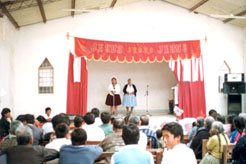 |
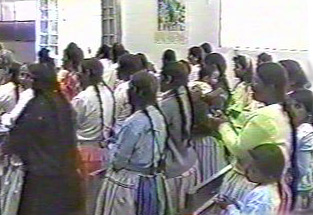 |
| Tarata, Bolivia (1994) | Evangelical Quechua church in Tarata, Bolivia. The Quechua people were very friendly and seemed contented in spite of the way they are denied equal opportunity within the local culture. It is in remote areas like this that you can see what good character in a person is really like. On the LEFT, two women sing a song on stage. On the RIGHT, people clap to one of the songs. In this church, the men were to the left and the women were on the right. |
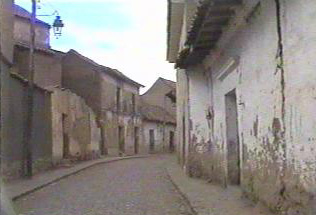 |
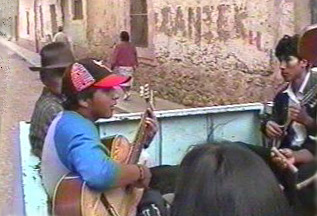 |
| Tarata, Bolivia (1994) | LEFT: Side road in Tarata. Most of the local construction is masonry. RIGHT: We have no need for a radio in our truck, since a local musical group to whom we gave a lift provided live music all the way back to Cochabamba! |
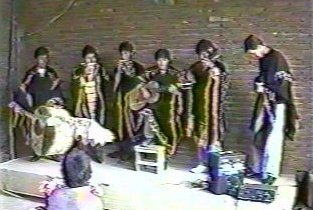 |
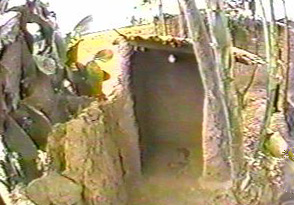 |
| Huasarancho, Bolivia (1994) | LEFT: A Musical group performing at a rural church in Huasarancho on 6 Nov. 1994. RIGHT: This is all there was for a restroom in the area. The doorless adobe structure is less than 1 meter square and 1.5 meters high, giving a new meaning to the term "public restroom!" The cement plug in the center is removable. (I had to visit any available restroom fairly often, after becoming ill due to exhaustion from unwanted political impositions.) In spite of apparent impoverished conditions, many area residents have electricity and are at least able to have televisions. |
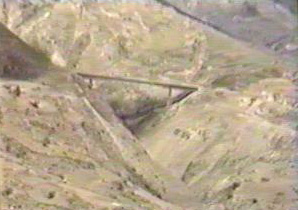 |
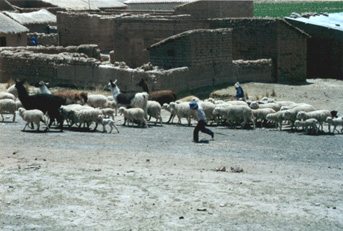 |
| Road from Cochabamba to the Altiplano in Bolivia (1994) | LEFT: Bridge in the rugged terrain between Cochabamba and Oruro. (Viaducto Alfonso Subieta, on 4.) The road reaches an elevation of 4,800 meters. RIGHT: A child shepherds sheep and llama a few kilometers outside the town of Caracollo, on the Bolivian altiplano. |
| Notes: Most images in this lower section and a few in my other eclipse photo pages were grabbed from my video with a Quantum Leap "Snap Magic" (TM) video frame grabber, which was provided to the Staigerland 1998 live eclipse web cast, courtesy of the manufacturer. I did not get go to the 1998 eclipse with them for finiancial reasons (was laid off from my job), but as a member of the E-team, I provided advice to others involved in the effort. The few video images posted in 2023 are from print screens that were performed while playing my video into a computer. |
|
Relevant Events After Original 1997 Publication of this 1994 Eclipse Web Page:
A Sad Day 29 Years Later: R.I.P. Wilma Silvia Alcocer Borda
|
An English translation of some of the above memorial text (per Google Translate) is: "You will always be in our hearts, until the day we meet again and are together. We will always need you; just remembering you will be enough to build our lives." "R.I.P. Ms. Prof. Wilma Silvia Alcocer Borda" "...Cemetery Jardin Parque de las Memorias" (Av. Circunvalacion, Cochabamba, Bolivia). This specific image and the text on it are © circa 1990 and 2023 by their (unknown) author(s). A eulogy of sorts for Wilma Alcocer is near the end of my 1994 Eclipse Chaser's Journal, Section 2. The the above announcement from Wilma Alcocer's family was not online, but the family member who sent it to me kindly gave me permission to post it here. The photo for it was taken several years before I met Wilma in 1994. The announcements linked below have a 2023 picture of her: From Sociedad Biblica Boliviana (23 Aug. 2023, on facebook): CONDOLENCIAS: Srta. Prof. Wilma Silvia Alcocer Borda From Colegio Evangelico Buenas Nuevas (24 Aug. 2023, on facebook): Quiero comunicar que falleció la Srta. Profa. Wilma Alcocer |
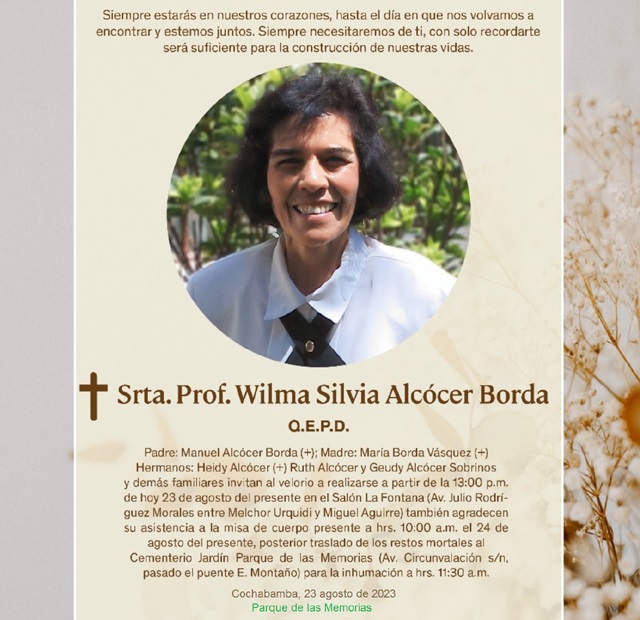 |
| For Alumni of Colegio Buenas Nuevas: If you are a former student of Collegio Buenas Nuevas who attended afternoon classes while Wilma Alcocer was a director there (est. 1978-1995, and 1997-2002 or so), and would like to share what you remember about Wilma with her sister's family in the USA or myself, feel free to write me (Jeff) at: jcharles *at* versacorp dot com. - I can pass your message along to her sister here in the USA if you approve. - If you write, please include "Wilma Alcocer" AND "Buenas Nuevas" in the subject line. - Please also indicate if you approve of your message being posted on a web page that is for any student memories of (or other messages about) Wilma Alcocer. (There are none as of 2/2024.) -- (If the school sets up a "Memories of.." web page, I will link to it instead of adding one here.) - I can currently only read English, but messages in Spanish are welcome, as I can use online translators to read them; and her sister's family of course does speak Spanish. - It will not be possible to set up a message board at this site, partly due to lack of time, and partly because I try to keep my web pages compatible with computers and browsers up to (and beyond) 25 years old, so people of modest means (who may have old computers, etc.) can access them. - I do not have any social media accounts because my responsibilities don't allow time for it. |
|
Recommended Reading: J. Charles' 1994 Eclipse Journal (corresponds to this image page): Section 1
J. Charles' 1994 Eclipse Journal (corresponds to this image page): Section 2 More of Jeffrey R. Charles' Eclipse Images (1979, 1991, 1995, 2017) Eclipse Chaser's Journal - All of Jeffrey R. Charles' Eclipse Expeditions Steps to a Successful Eclipse Expedition, by Jeffrey R. Charles Use of material herein is subject to conditions in the Versacorp Legal Information Page. Need information about eclipses for your planetarium, motion picture, or other project? Jeffrey R. Charles performs science consulting in regard to eclipse phenomena and instrumentation. Please direct inquiries to Jeffrey R. Charles (jcharles *at* versacorp dot com) or see the www.versacorp.com web page for more information about total solar eclipse related science and engineering consulting. |
|
Return to Local Table of Contents |
|
© Copyright 1994, 1997, 1998, 2017, 2023 Jeffrey R. Charles. All Rights Reserved. Jeffrey R. Charles (jcharles *at* eclipsechaser dot com)
Main Document Content Last (Significantly) Modified: 25 March, 1998 |
